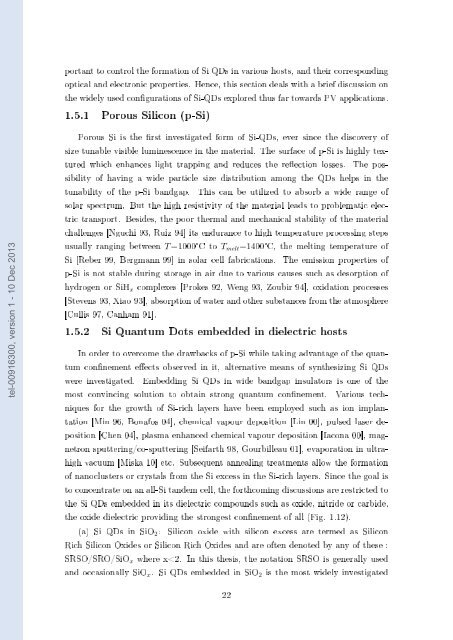Films minces à base de Si nanostructuré pour des cellules ...
Films minces à base de Si nanostructuré pour des cellules ...
Films minces à base de Si nanostructuré pour des cellules ...
Create successful ePaper yourself
Turn your PDF publications into a flip-book with our unique Google optimized e-Paper software.
portant to control the formation of <strong>Si</strong> QDs in various hosts, and their corresponding<br />
optical and electronic properties. Hence, this section <strong>de</strong>als with a brief discussion on<br />
the wi<strong>de</strong>ly used congurations of <strong>Si</strong>-QDs explored thus far towards PV applications.<br />
1.5.1 Porous <strong>Si</strong>licon (p-<strong>Si</strong>)<br />
tel-00916300, version 1 - 10 Dec 2013<br />
Porous <strong>Si</strong> is the rst investigated form of <strong>Si</strong>-QDs, ever since the discovery of<br />
size tunable visible luminescence in the material. The surface of p-<strong>Si</strong> is highly textured<br />
which enhances light trapping and reduces the reection losses. The possibility<br />
of having a wi<strong>de</strong> particle size distribution among the QDs helps in the<br />
tunability of the p-<strong>Si</strong> bandgap. This can be utilized to absorb a wi<strong>de</strong> range of<br />
solar spectrum. But the high resistivity of the material leads to problematic electric<br />
transport. Besi<strong>de</strong>s, the poor thermal and mechanical stability of the material<br />
challenges [Nguchi 93, Ruiz 94] its endurance to high temperature processing steps<br />
usually ranging between T=1000°C to T melt =1400°C, the melting temperature of<br />
<strong>Si</strong> [Reber 99, Bergmann 99] in solar cell fabrications. The emission properties of<br />
p-<strong>Si</strong> is not stable during storage in air due to various causes such as <strong>de</strong>sorption of<br />
hydrogen or <strong>Si</strong>H x complexes [Prokes 92, Weng 93, Zoubir 94], oxidation processes<br />
[Stevens 93, Xiao 93], absorption of water and other substances from the atmosphere<br />
[Cullis 97, Canham 91].<br />
1.5.2 <strong>Si</strong> Quantum Dots embed<strong>de</strong>d in dielectric hosts<br />
In or<strong>de</strong>r to overcome the drawbacks of p-<strong>Si</strong> while taking advantage of the quantum<br />
connement eects observed in it, alternative means of synthesizing <strong>Si</strong> QDs<br />
were investigated. Embedding <strong>Si</strong> QDs in wi<strong>de</strong> bandgap insulators is one of the<br />
most convincing solution to obtain strong quantum connement. Various techniques<br />
for the growth of <strong>Si</strong>-rich layers have been employed such as ion implantation<br />
[Min 96, Bonafos 04], chemical va<strong>pour</strong> <strong>de</strong>position [Lin 00], pulsed laser <strong>de</strong>position<br />
[Chen 04], plasma enhanced chemical va<strong>pour</strong> <strong>de</strong>position [Iacona 00], magnetron<br />
sputtering/co-sputtering [Seifarth 98, Gourbilleau 01], evaporation in ultrahigh<br />
vacuum [Miska 10] etc. Subsequent annealing treatments allow the formation<br />
of nanoclusters or crystals from the <strong>Si</strong> excess in the <strong>Si</strong>-rich layers. <strong>Si</strong>nce the goal is<br />
to concentrate on an all-<strong>Si</strong> tan<strong>de</strong>m cell, the forthcoming discussions are restricted to<br />
the <strong>Si</strong> QDs embed<strong>de</strong>d in its dielectric compounds such as oxi<strong>de</strong>, nitri<strong>de</strong> or carbi<strong>de</strong>,<br />
the oxi<strong>de</strong> dielectric providing the strongest connement of all (Fig. 1.12).<br />
(a) <strong>Si</strong> QDs in <strong>Si</strong>O 2 : <strong>Si</strong>licon oxi<strong>de</strong> with silicon excess are termed as <strong>Si</strong>licon<br />
Rich <strong>Si</strong>licon Oxi<strong>de</strong>s or <strong>Si</strong>licon Rich Oxi<strong>de</strong>s and are often <strong>de</strong>noted by any of these :<br />
SRSO/SRO/<strong>Si</strong>O x where x
















